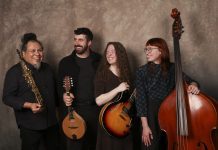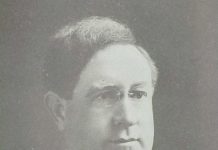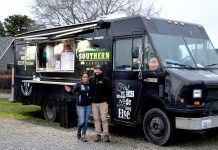Whether you’re at a school assembly or a sporting event, nothing summons some extra team spirit quite like a mascot.
Bellingham schools and sports teams have had an eclectic variety of costumed supporters over the years, from anthropomorphic hamsters to oversized Norsemen. The following is a fun sampling of mascots you may have seen around town, with emphasis on mascots outside of educational institutions (those will be covered in a future article).
Cluck and Dinger, Bellingham Bells Baseball
Although the Bellingham Bells have been represented by Dinger the Bellinghamster for years, they did not always have an ideal mascot.
In the early 2000s, for reasons that remain unclear, Bells ownership unleashed “Cluck the Chicken” as the team’s official mascot. The costume was basically a jersey-clad chicken wearing a cape – complete with an unsettlingly dead-eyed rubber chicken head.
“Somebody told me that they found that chicken at Goodwill,” says Stephanie Morrell, the Bells’ current general manager. “I don’t know if that’s true.”

A 2004 Bellingham Herald article noted that Cluck was a right-handed pitcher and would “probably taste great with sweet-and-sour sauce.”
Cluck continued bawking until around 2010. Another iteration of the costume made a final appearance at the Bells’ 20th anniversary celebration in 2019.
As part of the team’s rebranding in 2011, the Bells received new team colors, new uniforms, and a new mascot. That spring, Whatcom County baseball fans were informed the mascot would be a family-friendly hamster — a “Bellinghamster,” to be precise. The team even trademarked the term, which is a nickname for a Bellingham resident.
The costume was designed by Scollon Mascots, a company known for making mascots of Disney characters, and supposedly cost the team between $5,000 and $10,000, Morrell says.

Local residents were asked to vote for the hamster’s name, and given the choices of Hammy, Homer, Dinger, and a write-in. Nearly 200 votes later, Dinger emerged the clear winner. His name provides a dual meaning, referring to both the nickname for a home run and the “ding-dong” sound a bell makes.
Dinger’s original form faithfully entertained the masses until 2023, when the costume underwent a needed refresh by Maydwell Mascots, a Canadian company with a list of clients including the Chips Ahoy! cookie. In addition to losing weight, Dinger also gained shoes and baseball pants.
Fit and furry as ever, Dinger continues bringing joy and team spirit to Bells home games, which include his signature 5th inning “Dinger Run” across the infield with children. On a team that sees constant turnover due to its collegiate make-up, Dinger is among the few constants of attending a game.
“It’s a memorable part of people’s experiences,” Morrell says.
Baker the Mountain Goat
In the mid-1980s, a new “ambassador for tourism” appeared in Whatcom County. He was tall, furry, and horned — and his name was Baker.
Initially introduced as the official mascot of the Ski to Sea Festival in May 1985, Baker the Mountain Goat was created to represent Whatcom County at local and regional community events.
The mascot was originally owned by the then-named DARE Association of the Whatcom Chamber of Commerce and Industry, which chose the mountain goat mascot after officials saw a commemorative pin from the Mount Baker Marathon, according to a 1988 Herald article.
Baker continued appearing in the Ski to Sea Grand Parade through at least 2004, according to parade entry lists. In 2000 he even entered national politics, riding in a parade truck adorned with signs reading “Vote Goat” and “Baker for President.”

Baker endured a long hibernation until 2022, when Ski to Sea Race Director Anna Rankin was cleaning the Whatcom Events office and found the costume. In 2023, he re-appeared in that year’s St. Patrick’s Day parade. Rankin says they considered having Baker also participate in Ski to Sea, but nobody was willing to wear the costume.
Despite his age, Rankin says Baker is still in decent shape, and will continue being a proud part of Ski to Sea’s heritage in some form.
“It’s pretty historic,” she says of the costume. “I can’t believe we still have it.”
Sammy the Salmon
The Nooksack Salmon Enhancement Association’s official mascot has popped up at plenty of community events — sometimes with an assistant dressed like a fisherman — since debuting around 1983.
According to Amy Johnson, NSEA’s development manager, Sammy was commissioned by Heather Higgins of Bellingham’s Maritime Heritage Center for the city’s education programs.
“Sammy’s job is spreading cheer and creating awareness about salmon,” says Johnson. “They even have a coloring book that tells the tales of life as a salmon.”
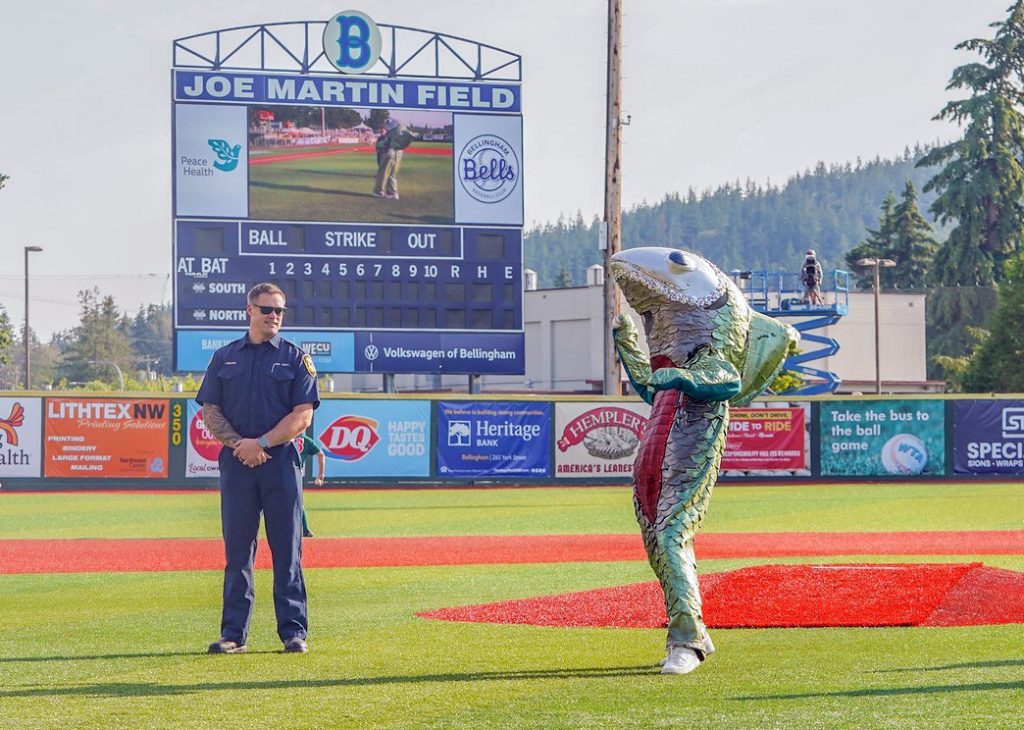
The Coho costume was designed by Donna and Roger Germain — an Everson couple who designed multiple mascots for local organizations of the era, including Wally Whatcom the Museum Mouse and the KISM 92.9 FM beaver, according to a 1988 Herald article. Donna studied theater costuming at WWU, and Roger was a scene shop director at the university’s College of Fine and Performing Arts. There are several versions of the costume, which has been spruced up occasionally to continue being used after so many years.
The Herald article describes Sammy as enjoying “sea shanties, horn pipe music, and maritime tunes,” but also prone to embarrassment when children ask how many offspring the fish has fathered. Sammy was also once in a long-distance relationship with “Salley Sockeye,” a fish mascot from Snohomish County, the article states.
Sammy is brought to life by a variety of staff, board, and community volunteers, and makes frequent appearances at local events, including the Bellingham SeaFeast and Run with the Chums 5k.
Wally Whatcom the Museum Mouse
The dapperly-dressed Wally Whatcom was introduced to the masses in 1988 and has represented Bellingham’s Whatcom Museum ever since.
Museum Archivist Jeff Jewell says Richard Vanderway, the museum’s former curator of education, was and early promotor of Wally and likely the first to don the costume. In a 1988 Herald article, Vanderway provided Wally’s origin as having been born in a log cabin belonging to Bellingham pioneer Edward Eldridge. Eventually, Wally moved into the museum and began educating himself on local history and art.
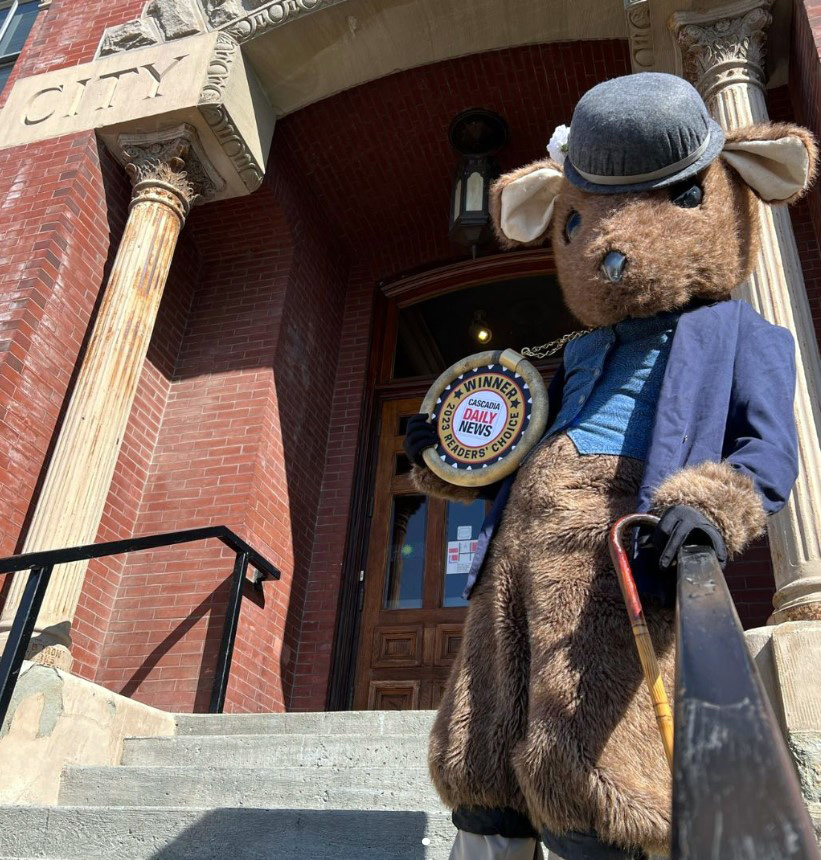
Wally appeared at many public festivities over the years, including the 1988 opening of Bellis Fair Mall, the 1993 opening of the Peace Arch Factory Outlets, and numerous Ski to Sea parades through the mid-2000s. He even had his own section, “Here’s Wally,” in the children’s section of the mid-1990s Herald.
Wally was also joined by a female friend, Winnie, though Jewell says she was never used as often as Wally and is likely still in storage somewhere. While Wally’s head was occasionally updated over the years, the changes were not always to people’s liking:
“A lot of people complained that it didn’t look like a museum mouse,” Jewell said of one particular head style that’s no longer used. “It looked like a museum rat.”
While Wally Whatcom made few appearances in the 2010s, he began appearing more frequently in the years following the COVID-19 pandemic. Over the decades, various museum educators have stepped into the costume, even though there was no extra pay for doing so.
So, did Jewell ever want to become Wally?
“It never really caught my interest,” he says with a laugh.



